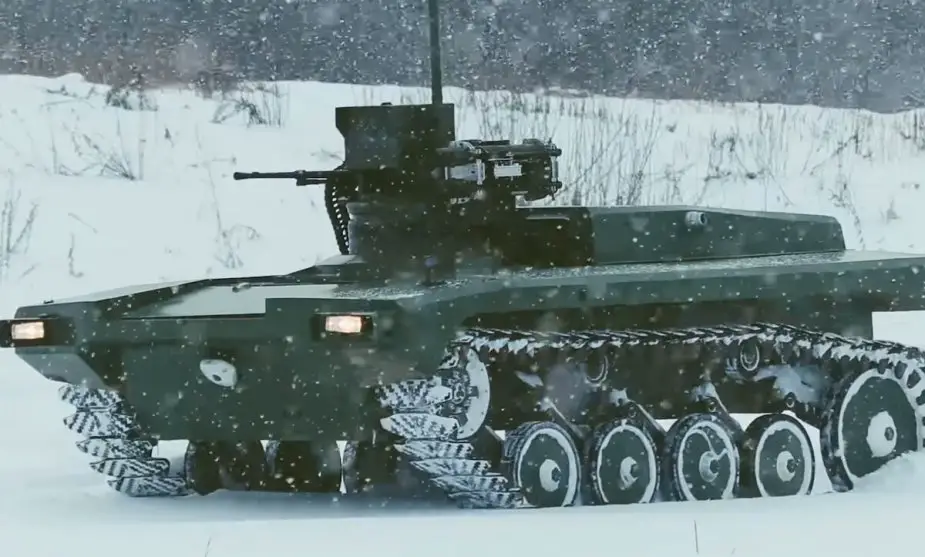Breaking news
Russian Marker UGV robot to operate in friend-or-foe identification mode.
The Marker robotic system will be taught to operate in the friend-or-foe identification mode, the press office of Android Technics company told TASS. “Before starting to identify intruders, it is necessary to digitalize all personnel and employees, enter them into the database and teach the robot to work in the friend-or-foe identification mode,” the press office said.
Follow Army Recognition on Google News at this link

The Marker UGV during testing in December 2019 (Picture source: Advanced Research Foundation)
According to the press office of Android Technics company, one robot has passed tests at the Vostochny spaceport. It patrolled the perimeter autonomously, identified ground infrastructural facilities, interacted with security guards. “The trials lasted 10 days and resulted in a report and a plan to adjust the system,” the press office said.
According to the press office, the Vostochny cosmodrome is a unique testing ground for developing robotic technologies. “After technologies are tested at the Vostochny spaceport, they can be further used at other ground-based space infrastructural facilities, including the Baikonur cosmodrome and others,” the press office said.
Earlier, Head of Russia’s Roscosmos state space corporation Dmitry Rogozin said that the Marker robotic platform had started to patrol the Vostochny cosmodrome. According to him, the Marker operated in remote-controlled and autonomous modes.
The Marker robot has been designed by the National Center for the Development of Technology and Basic Elements of Robotics and the Android Technics company. Marker is designed to be modular, with open information architecture. One configuration for the testbed arms it with a Kalashnikov-produced machine gun and anti-tank grenade launchers. More armament combinations may be expected to be tested. What deserves to be observed in the video is the way the turret on the robot tracks a target with the rifle carried by the infantryman. In an official statement from ARF, the agency said the Marker is designed to work “in pair with a fighter, receiving target designation from the sight of his weapon,” or be controlled remotely. So, the Marker would shoot only after the accompanying infantryman has validated the target. But it could operate autonomously if programmed to do so.
A modular multispectral vision and data processing system, featuring neural network algorithms, supports autonomous operations. Other mission systems include a laser warning system, thermal sensors, day/night infrared (IR) cameras, laser rangefinder, target detection, early warning system, identification, and tracking equipment. This generates a new way of cooperation between man and robot where AI-powered sensors take aim and the human checks in before firing. It turns infantry into spotters for robots that will progress on the path of autonomy. ARF clearly sees the Marker as a learning tool, saying “the evolution of combat robots is on the path of increasing the ability to perform tasks in autonomous mode with a gradual reduction in the role of the operator."
The Marker robot will be able to carry a machinegun, loitering munitions and two types of unmanned aerial vehicles (UAVs), the press office of the Android Technics Research and Production Association told TASS. “The Marker robot can be used with various modules and can carry a machinegun, loitering munitions, military and medical equipment, electric rockets, and two types of unmanned aerial vehicles, i.e. tube-launched and towed ones,” the press office said. Earlier, Head of Russia’s Roscosmos state space corporation Dmitry Rogozin said that the Marker robotic platform had started to patrol the Vostochny cosmodrome. According to him, the Marker operated in remote-controlled and autonomous modes.
Russian enterprise develops module to control several Marker robots simultaneously
A module to control several Marker robotic platforms at a time has been developed, Deputy Head of the Software System Department from the State Scientific Research Institute of Aviation Systems (GosNIIAS) Boris Vishnyakov told TASS: “Our colleagues have developed autonomous motion and motion control modules for several platforms,” Vishnyakov said. According to the specialist, modules for working with equipment, 2D and 3D object recognition, semantic segmentation, depth calculation, automatic self-localization, trajectory building, passability measurement have been developed.
© Copyright 2021 TASS / Army Recognition Group SPRL. All rights reserved. This material may not be published, broadcast, rewritten or redistributed.


























